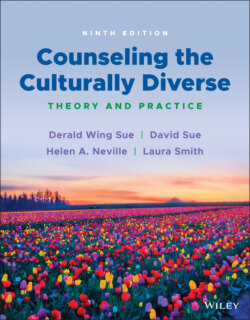Читать книгу Counseling the Culturally Diverse - Laura Smith L. - Страница 61
DID YOU KNOW?
ОглавлениеSome studies seem to suggest that White female trainees are more attuned to their biases, and score higher than their male counterparts on measures of multicultural counseling competence. If true, what might account for these findings?
Source: Spanierman, Poteat, and Wang (2008).
More recently, Owen and colleagues have proposed a multicultural counseling orientation model (MCO) that extends and complements the awareness, knowledge and skills framework of cultural competence (Davis et al., 2018; Owen et al., 2011). The MCO model posits three different process dimensions of cultural sensitivity: (a) cultural humility, (b) cultural comfort, and (c) cultural opportunity. The most prominent of these three is that of cultural humility.
The concept of cultural humility was first coined in medical education, where it was associated with an open attitudinal stance or a multicultural open orientation to diverse patients (Tervalon & Murray‐Garcia, 1998). The term has found its way into the MCT field, where it also refers to an openness to working with culturally diverse clients (Hook, Davis, Owen, Worthington, & Utsey, 2013; Owen et al., 2014). As more counselors and psychologists have begun to study cultural humility, it has become clear that this concept is a “way of being” rather than a “way of doing,” which also characterizes cultural competence (Owen, Tao, Leach, & Rodolfa, 2011). Cultural humility as an orientation or disposition is thus necessary to facilitate cultural awareness, knowledge, and skills. A counselor must adopt an open, inquisitive orientation in order to engage in self‐reflection and to learn from clients and marginalized communities, which are key ingredients of cultural competence. In a therapeutic context, cultural humility of therapists (a) is considered very important to many socially marginalized clients, (b) correlates with a higher likelihood of continuing in treatment, (c) strongly relates to the strength of the therapeutic alliance, and (d) is related to perceived benefit and improvement in therapy (Hook et al., 2016). Thus, cultural humility as a dispositional orientation may be equally important as three major cultural competence domains (awareness, knowledge, and skills) in MCT.
Increasingly, scholars have also begun to make a strong case that cultural comfort and cultural opportunity are also correlated with effective MCT. In Chapter 1 a strong case was made about how differences create discomfort and evoke powerful negative emotion in many trainees. The concept of cultural comfort refers to a therapist's feeling at ease, calm, relaxed, and open to work with diverse clients. It makes sense that when a counselor is anxious and uncomfortable with topics of race, gender, and sexual orientation it will negatively affect the therapeutic relationship. Likewise, the concept of cultural opportunity refers to “markers” that occur in therapy when clinical openings present themselves where client's cultural beliefs, values and identity can be explored (Davis et al., 2018). Dr. D. missed many opportunities to understand Gabriella's worldview in a deeper manner because he was either uncomfortable with exploring them or was clueless about their implications.
